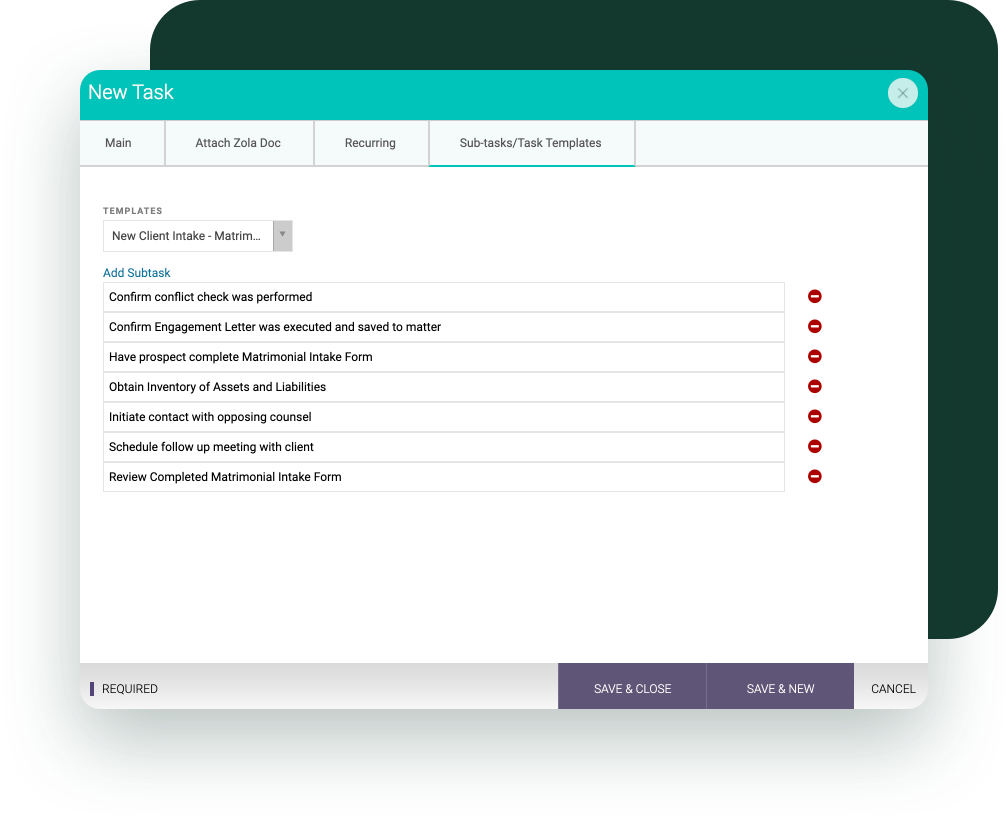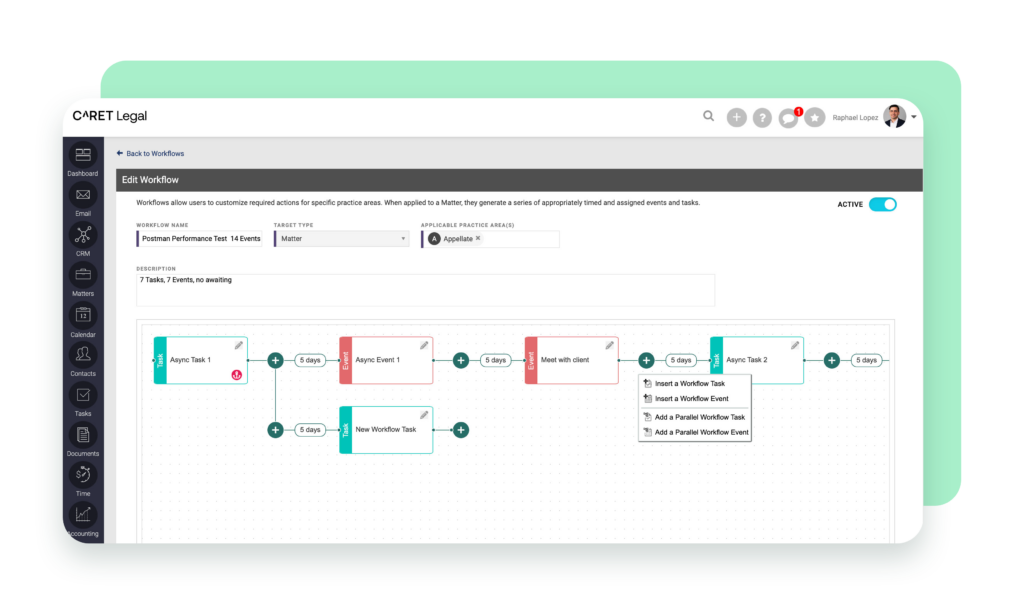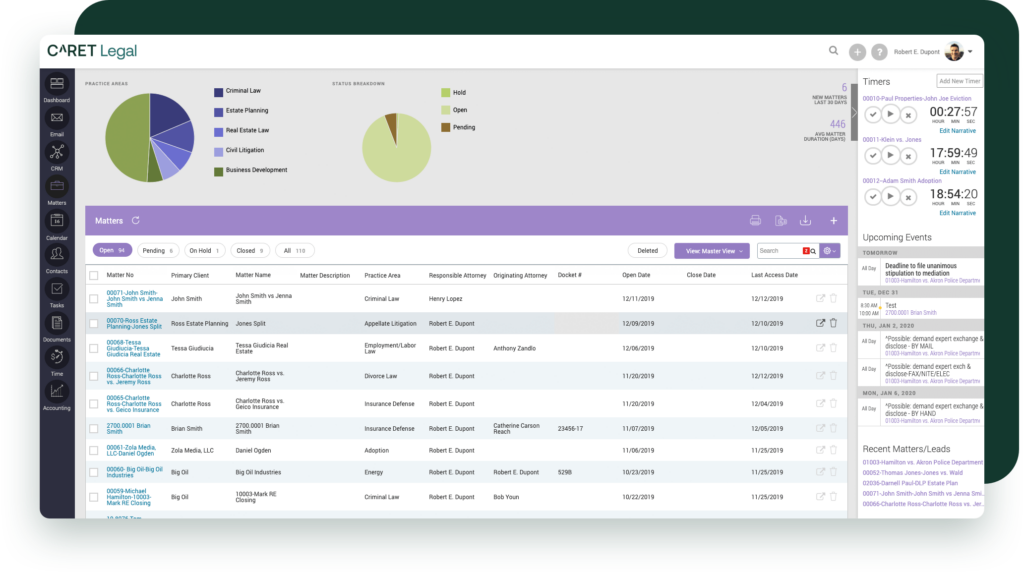Optimizing your case management processes enables you to deliver better services, maximize potential, and stay ahead in a competitive market.
Automating your legal case management workflows can improve efficiency, productivity, and client satisfaction. From assessing your current workflows to implementing legal task management software and fostering a culture of continuous improvement, these strategies will empower your law office to optimize processes, enhance communication, and achieve better outcomes. By implementing these actionable steps, you can pave the way for a more efficient and successful legal case management workflow process.

CARET Legal task management allows lawyers to create tasks specific to each matter.
Step 1: Identify the Deficiencies
Identifying deficient areas in your legal case management workflow is the first step to improving operations. Optimizing your case management processes enables you to deliver better services, maximize potential, and stay ahead in a competitive market. Common deficiencies in case management workflows can include:
- Lack of Organization: A deficient case management workflow may lack clear structure and organization, leading to confusion and inefficiency in managing legal cases. This can result in missed deadlines, misplaced documents, and difficulty in tracking the progress of cases.
- Inefficient Communication: Poor communication can hinder collaboration among team members. This can lead to delays in sharing important information, miscommunication of instructions, and a lack of coordination in handling legal cases.
- Time-consuming processes: If your office relies heavily on manual tasks and paperwork, it can slow down the overall progress of cases. This can result in wasted time, increased administrative burden, and decreased productivity for lawyers and staff.
- Limited Access to Information: By not having easy access to case-related information and documents the efficiency of legal professionals can be hindered. This can result in time wasted searching for information, potential errors in documentation, and a lack of transparency in case management.
- Inadequate task management: A fragmental workflow may lack a systematic approach to task management, making it difficult to assign, track, and prioritize tasks related to legal cases. This can lead to confusion, overlapping responsibilities, and delays in completing essential tasks.
By automating repetitive tasks such as document generation, time tracking, and billing, valuable time is saved and the likelihood of errors is reduced.
Step 2: Vet, Choose, and Implement a Solution
Once you’ve identified the deficiencies in your current case management workflow, the second step is to vet, choose, and implement a legal practice management system. Make sure whatever solution you choose features the following:
- Enhanced Organization: Automating your legal case management workflow provides a centralized platform where all case-related information, documents, and tasks can be stored and accessed in a highly organized manner. It offers features like folders, tags, and labels to categorize and sort information, making it effortless to locate and retrieve relevant documents quickly.
- Orderly Communication: Efficient communication within a legal office results in seamless collaboration. CARET Legal offers a client messaging system, shared calendars, and task assignments that enable real-time communication among team members. Users can send messages, share updates, and assign tasks directly within the software, eliminating the need for lengthy email chains or physical memos.

CARET Legal Workflows take care of scheduling and reminding, freeing you and your team to focus on what matters most – your clients.
- Time-saving Automation: By automating repetitive tasks such as document generation, time tracking, and billing, valuable time is saved and the likelihood of errors is reduced. Additionally, workflow management tools allow users to create standardized processes and track the progress of tasks, ensuring that deadlines are met and reducing time wasted on unnecessary steps.
- Adaptable Workflow Automation: An optimal legal practice management system should be both flexible and adaptable. With a solution like CARET Legal, users can easily customize workflow automation processes, allowing for adjustments or optimizations without the need for a consultant or a lengthy, costly process. This means workflows can evolve with your firm’s needs, enhancing case management efficiency and boosting productivity without incurring additional operational costs.
- Enhanced Access to Information: By using cloud-based storage, users can access case-related information from anywhere and at any time eliminating the limitations of physical files or local servers. With improved access to information, legal professionals can make informed decisions, collaborate effectively, and provide better service to clients.
- Effective Task Management: Robust task management capabilities enhance productivity and ensure tasks are properly managed. It allows users to create, assign, and track tasks, set deadlines, and monitor progress. This prevents important tasks from falling through the cracks and ensures that everyone is aware of their responsibilities by providing reminders and notifications to keep users informed about upcoming deadlines and overdue tasks.

CARET Legal provides a consolidated bird’s eye view of all the elements related to a case.
Step 3: Assess and Iterate for Continuous Improvement
To truly foster a culture of continuous improvement, it is essential to go beyond the initial implementation. By following the steps below, you can ensure your legal case management workflow becomes a catalyst for ongoing enhancements and optimizations in your practice.
- Encourage feedback: Regularly seek feedback from employees regarding their experience with the technology solution. Ask for suggestions on how to improve its functionality, user interface, and overall effectiveness. Actively listen to their input and consider implementing their ideas when feasible.
- Monitor performance: Utilize the reporting and analytics features of the case management software to monitor the performance of the workflow. Identify bottlenecks, inefficiencies, or areas for improvement. Analyze data on case timelines, task completion rates, and client satisfaction to inform decision-making and identify areas where adjustments can be made.
- Promote collaboration: Leverage collaborative features to encourage teamwork and communication. Foster a culture of sharing best practices and encourage employees to collaborate on cases, share insights, and provide feedback.
- Regularly review and refine processes: Continuously evaluate and refine the legal case management workflow processes based on insights gained from technology use. Identify any redundant or unnecessary steps and automate the workflow if possible.
- Recognize and reward improvement: Acknowledge and reward employees who actively contribute to improving the legal case management workflow using the software. Celebrate successes and share success stories to motivate others to embrace continuous improvement.
Start Improving Your Legal Case Management Workflow Now
To truly improve your legal case management workflow, consider utilizing a comprehensive legal practice management software like CARET Legal. With its robust features, customizable options, and user-friendly interface you can further improve your workflow, centralize case information, and reinforce collaboration among team members. Get started with a free trial, or request a demo today.
